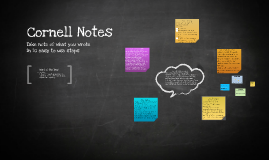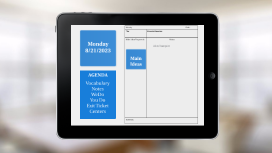Cornell Note Presentation
Transcript: Cornell Notes Overview -It's a process rather than a style -Several of the 10 steps are already things we do -Once the students become familiar with the process, some of the steps become habit -Not all Cornell Notes must look the same. There are multiple formats, use what works best for your classroom. Process is what is important. Step 3, 4, & 5: Review/Revise, Note Key Ideas, and Collaborate -Discuss notes with a partner or group -Fill in any "gaps" or missed information -Discuss and mark (star, highlight, underline, etc) important information -Determine the purpose of the information -Develop questions/or topics on the left side of the paper that identify the main ideas on the right side -Encourage higher level questions, but not all information will lend itself to higher level -These are floating steps that can be completed during breaks in information or after an entire presentation is done rep-e-ti-tion 1. the act of repeating; repeated action, repeating, over and over, multiple times, repetitiously, repeatedly Cornell Notes Word of the Day! Step 1: Note Set up -Provide students with paper or have students create their own -The Essentials: Name, Date, Class Essential Question: Provided by the teacher before the notes begin and based on the objective of the information being given If students are using their own paper, have them leave space to the left (1/3 of pg) and at the bottom (2 inches) Take note of what you wrote in 10 easy to use steps Step 2: Notes on the Right -students take notes from lectures, videos, readings, class discussions, etc. -students should take notes in their own words: abbreviations, shorthand, lists, bullets, whatever works for them -Guide the students focus on important information -Steps 3-5 will allow students to get any information they miss, so keep calm and carry on Steps 7, 8, 9, & 10: Making the most out of C-Notes -Use the notes as a learning tool: to study for assessments, create left hand questions as a warm-up/bell ringer, check notes as a participation grade, use notes as basis for socratic seminars -Using the notes as a learning tool provides an opportunity for students to commit information to long term memory -Periodically check notes and create goals to: improve listening skills, help students determine what is important information, promote higher order thinking, or identify areas of confusion Step 3, 4, & 5: Review/Revise, Note Key Ideas, and Collaborate -Discuss notes with a partner or group -Fill in any "gaps" or missed information -Discuss and mark (star, highlight, underline, etc) important information -Determine the purpose of the information -Develop questions/or topics on the left side of the paper that identify the main ideas on the right side -Encourage higher level questions, but not all information will lend itself to higher level -These are floating steps that can be completed during breaks in information or after an entire presentation is done Step 6: Summarize -Create a 1-3 sentence summary that answers the initial essential question -Review notes taken, questions developed, and prior knowledge to identify main ideas to be used in the summary -Students should be synthesizing information rather than just restating information -Summary gives the student the opportunity to pinpoint any remaining points of confusion

















